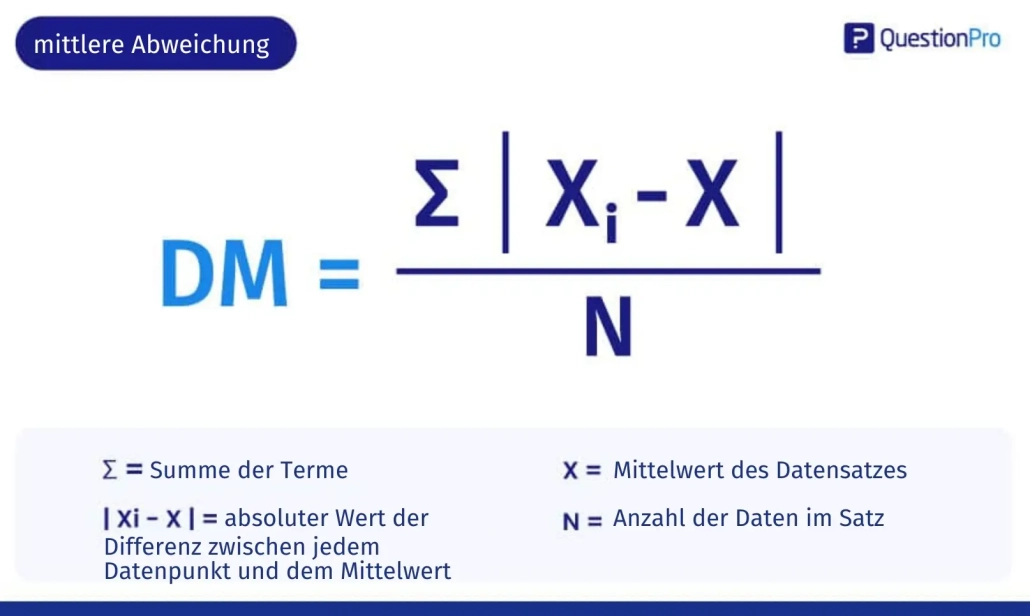Market research
In statistics it is mean deviation an important measure of dispersion that allows us to understand how much the data deviates from an average value.
Deviation is a fundamental tool for analyzing and understanding data sets in various disciplines, such as economics, psychology, medicine, and many others.
Understanding how to calculate and use them is critical to making accurate statements and making data-driven decisions. This article explains what variance is, how it is calculated, and why it is important in data analysis.
CONTENT
- 1 What is the mean deviation?
- 2 Using mean deviation
- 3 Formula for calculating the mean deviation
- 4 Example of mean deviation
- 5 Difference between mean deviation and standard deviation
- 6 Conclusion
- 7 1:1 Live Online Presentation: QUESTIONPRO MARKET RESEARCH SOFTWARE
- 8 Try software for market research and experience management now for 10 days free of charge!
What is the mean deviation?
Mean deviation is a measure used to understand how far the data deviates from an average set.
It is a measure that helps us understand how much the data deviates from an average rate. If the deviation is large, it means that the data is widely spread or different, while a small deviation means that the data is very close together.
Using mean deviation
Here are some cases where this deviation can be of great benefit:
- Comparison of data: If you have two sets of data with different averages, you can use variance to determine which of the two sets has more scattered or variable data.
- Evaluation of results: When you conduct an experiment or test and have a range of results, variance can help you determine the accuracy of your results. A high variance indicates that the results may be less accurate.
- Quality control: In product quality control, mean deviation is often used to evaluate product variability. A high deviation may indicate that there are problems with production or product quality.
- Risk Analysis: In financial risk analysis, mean deviation is often used to assess the volatility of a financial asset. The greater the deviation, the greater the risk associated with the financial asset.
In general, mean deviation is a useful measure for understanding the variability of data in a set and can be used in many different situations.
Formula for calculating the mean deviation
The simple formula for calculating the mean deviation is as follows:
Mean deviation = Σ | Xi – X | / N
where:
- Σ = sum of terms
- | Xi – X | = Absolute value of the difference between each data item and the mean
- X = average of the data set
- N = Number of data in the set
In simple terms, to calculate the deviation, the absolute differences between each value in the data set and its mean are summed and the result is divided by the total number of data. The result is divided by the total number of data. This formula gives a measure of the average spread of the data in the data set relative to its mean.
Example of mean deviation
Here is a simple example of calculating mean deviation:
Suppose we have the following data: 2, 4, 6, 8, 10.
To calculate them, we first need to calculate the average of the data:
X = (2 + 4 + 6 + 8 + 10) / 5 = 6
Now we can calculate the deviation using the formula:
Mean deviation = Σ | Xi – X | / N
DM = (|2 – 6| + |4 – 6| + |6 – 6| + |8 – 6| + |10 – 6|) / 5
DM = (4 + 2 + 0 + 2 + 2 + 4) / 5
DM = 2,4
So the variance of this data set is 2,4. This means that, on average, the values of the set deviate from their mean by 2,4 units.
Difference between mean deviation and standard deviation
Both mean deviation and standard deviation are measures of dispersion used to evaluate the variability of data in a set. However, there are some key differences between them:
- Calculation formula: The mean is calculated by taking the arithmetic mean of the absolute differences between each value and the mean of the set. The standard deviation, on the other hand, is determined by taking the square root of the Variance calculated.
- Sensitivity to extreme values: The mean is more sensitive to extreme values or outliers in the data set because it is calculated using the absolute differences between each value and the mean. Standard deviation, on the other hand, is less sensitive to outliers because it is based on the mean square of the differences, which reduces the impact of outliers.
- interpretation: The mean is interpreted as the average measure of the distance of the values in the data set from the mean. The standard deviation, on the other hand, is interpreted as an average measure of the distance between the values in the data set and the mean in the form of their standard deviation.
In short, both are measures of dispersion used to evaluate the variability of the data in a set. The mean deviation is more sensitive to extreme values, while the standard deviation is less sensitive and allows a clearer interpretation in terms of its standard deviation.
Conclusion
In summary, it can be said that the mean deviation is an important measure of the dispersion in the Intelligent Data Analysis is that allows us to understand how much the data varies in an average set.
By calculating and analyzing them, we can gain a deeper understanding of the data and make fact-based decisions more accurately. QuestionPro's survey and data analysis tool allows you to collect and analyse your research data. Additionally, the wide range of tools allow you to delve even deeper into your data and gain valuable insights.
Don't hesitate and use QuestionPro for your next project. Request a demo now! or use a free account.
1:1 live online presentation:
QUESTIONPRO MARKET RESEARCH SOFTWARE
Arrange an individual appointment and discover our market research software.
Try software for market research and experience management now for 10 days free of charge!
Do you have any questions about the content of this blog? Simply contact us via contact form. We look forward to a dialogue with you! You too can test QuestionPro for 10 days free of charge and without risk in depth!
Test the agile market research and experience management platform for qualitative and quantitative data collection and data analysis from QuestionPro for 10 days free of charge
FURTHER KEYWORDS
SHARE THIS ARTICLE
KEYWORDS OF THIS BLOG POST
mean deviation | Deviation | Formula
FURTHER INFORMATION
- Applied Research: Definition, Types and Examples
- Experimental research: what it is, what types there are and how to carry it out
- Types of research and their features
- What is exploratory research?
- Mixed methods research: what it is and what types there are
- Data filtering: what it is, benefits and examples
- Data collection tools: which are the best?
- Big Data and Artificial Intelligence: How do they work together?




